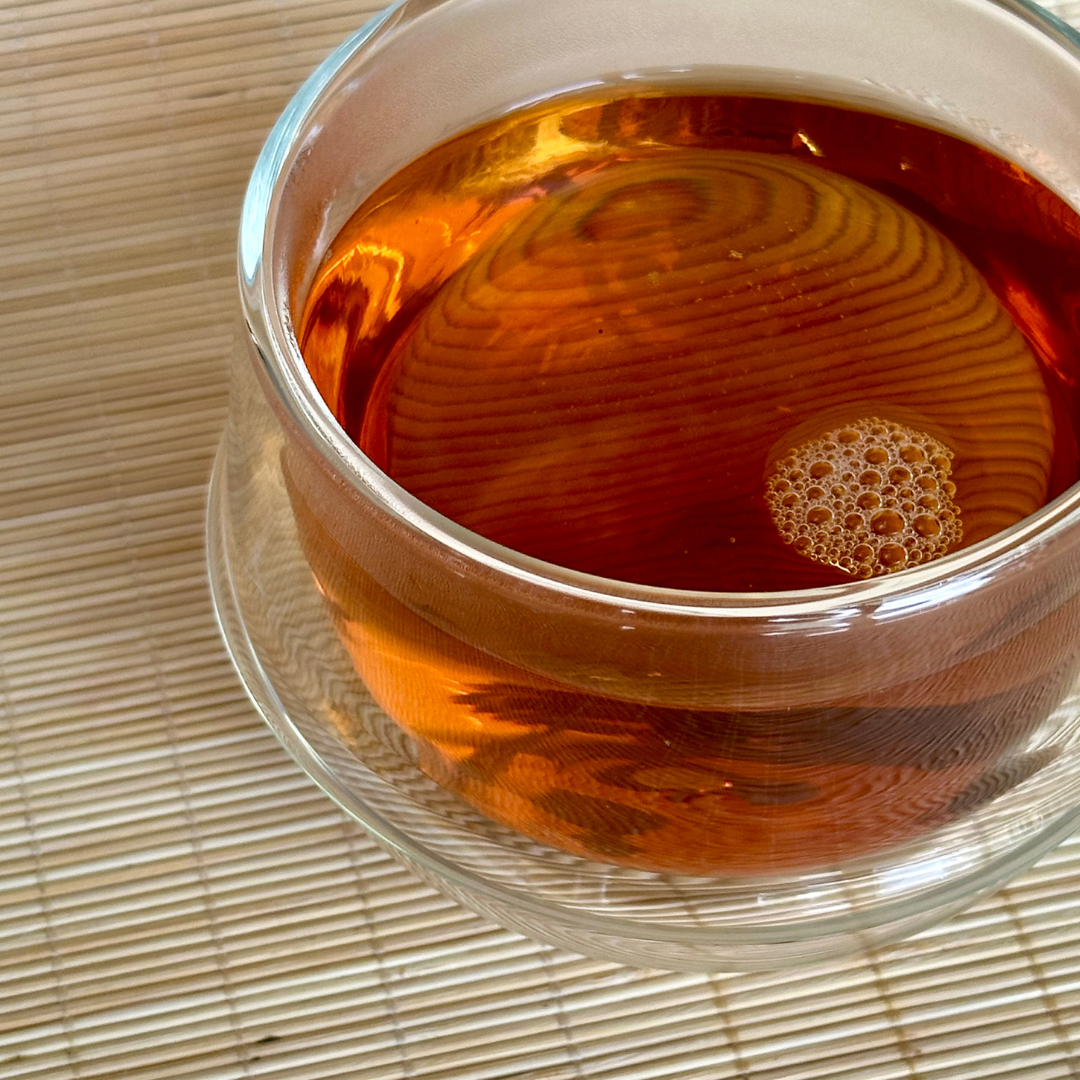-
The Rou Gui cultivar, though not precisely documented, is believed to have originated during the Qing Dynasty (1644-1912). Tea cultivation in the Wuyi Mountains dates back to the Song Dynasty (960-1279), and this region is famous for its distinctive rock teas. The unique terrain and historical significance of the area contribute to the tea's unique characteristics and reputation.
This Rou Gui is grown in the rocky terrain of the Wuyi Mountains, which significantly influences its flavor profile, giving it the characteristic yan yun or rock rhyme—an essence that captures the mineral complexity of its terroir. We like to refer to yan yun as the poetry of mountains. The leaves are dark and twisted, traditionally processed through stages of withering, tossing, oxidation, and charcoal roasting, a method that enhances the tea's spicy and floral notes.
The traditional processing of Rou Gui includes meticulous withering, rolling, oxidation, and a significant roasting process, often done over charcoal. This roasting varies from light to heavy, influencing whether the tea's profile leans more towards vivid floral and fruity notes or richer, spicier undertones. This careful crafting process ensures each batch of Rou Gui retains its classic flavors while highlighting subtle nuances.
-
Rock tea (also known as Cliff Tea), or Yan Cha (岩茶), from the Wuyi Mountains in northern Fujian Province, China, is renowned for its distinctive flavor and rich history. The unique rocky terrain and mineral-rich soil of Wuyishan provide the perfect environment for cultivating Yan Cha, contributing to its famous rocky taste, often referred to as yan yun (rock taste). We like to refer to yan yun as the poetry of mountains. Celebrated since the Song Dynasty, Yan Cha saw a pivotal shift during the Ming Dynasty with the advent of loose-leaf tea processing, paving the way for the complex oolong teas we know today.
The high-altitude gardens of Wuyishan, averaging 650 meters above sea level, have a cool, moist climate that fosters ideal growing conditions for the many varieties of Camellia sinensis that thrive here. The production areas in Wuyishan are categorized into three types based on location and soil quality:
Zheng Yan Cha (inside the mountain tea)
Ban Yan Cha (half rock soil tea, in the foothills of the mountain)
Zhou Cha (outside of the mountain tea)
The region is renowned for the Nine Bend River, 36 summits, and 99 rocks the size of mountains. One reason Zheng Yan Cha is so prized, besides the soil, is its rarity, as the entire tea-growing region is a national park.
Famous varietals like Da Hong Pao (Big Red Robe), Tie Luo Han (Iron Warrior Monk), Bai Ji Guan (White Cockscomb), and Shui Jin Gui (Golden Water Turtle) emerged during the Qing Dynasty, each with unique characteristics. Traditional processing techniques, including withering, tossing, oxidation, and roasting, contribute to Yan cha's unique flavor profile.
Integral to Chinese tea culture and often associated with Gong Fu Cha, Rock Tea has gained international acclaim, making it a prized possession for tea connoisseurs worldwide. Its production continues to be economically significant for the Wuyi region, reflecting a deep cultural heritage that intertwines nature and artistry. The unique terroir of the Wuyi Mountains, characterized by its mineral-rich soil, high humidity, and moderate climate, imparts a distinct flavor profile to Yan Cha, making it a true representation of its place of origin.
Spiritual Significance of Wuyishan
Wuyishan is also a place of profound spiritual significance:
Daoism and Buddhism: Wuyishan has been a significant site for both Daoism and Buddhism. Many temples and monasteries are scattered throughout the region, reflecting its role as a center for spiritual practice and pilgrimage. The harmony between the natural environment and the built spiritual structures embodies the Daoist principle of harmony with nature.
Sacred Landscape: The stunning natural scenery of Wuyishan, with its dramatic cliffs, winding rivers, and lush forests, has long been regarded as a sacred landscape. The unique rock formations and the Nine Bend River are believed to possess spiritual energy, attracting seekers of inner peace and enlightenment.
Cultural Heritage: Wuyishan is also famous for its contribution to Chinese tea culture, particularly Da Hong Pao and other rock teas. Tea culture itself has spiritual dimensions, emphasizing mindfulness, tranquility, and a deep connection to nature.
Historical Figures: Several renowned historical and spiritual figures have been associated with Wuyishan. For example, Zhu Xi, a famous Confucian scholar, spent time in the area, contributing to its reputation as a place of intellectual and spiritual significance.
Natural Conservation: The reverence for Wuyishan's natural environment reflects broader Chinese spiritual and philosophical views that emphasize the importance of living in harmony with nature. The preservation of its biodiversity and natural beauty is seen as a spiritual duty and a form of respect for the Earth.
-
Rich in Antioxidants: Neutralizes harmful free radicals and promotes overall health.
Digestive Aid: Enhances digestion and soothes the stomach, ideal for after meal enjoyment.
Stress Reduction: The act of brewing and savoring the tea, coupled with its warm, spicy aroma, can significantly reduce stress.
Sustained Energy: Contains low to moderate levels of caffeine, offering a gradual boost of energy.
-
Preparation Method
Western Preparation:
Use 4-5 grams of tea per 6-8oz of 190°F (88°C) using a teapot, kyusu or infuser mug
Steep for 1-3 minutes
Good for multiple steeps
Eastern Preparation with rinse (Gong Fu Cha):
Use 4-7 grams of tea per 100ml of water at 205°F (96°C) using a gaiwan or small teapot
Flash rinse the leaves to awaken and prepare
Steep for 10-20 seconds
Increase steeping time by 5-10 seconds with each subsequent infusion
Enjoy multiple infusions to savor the evolving flavors






